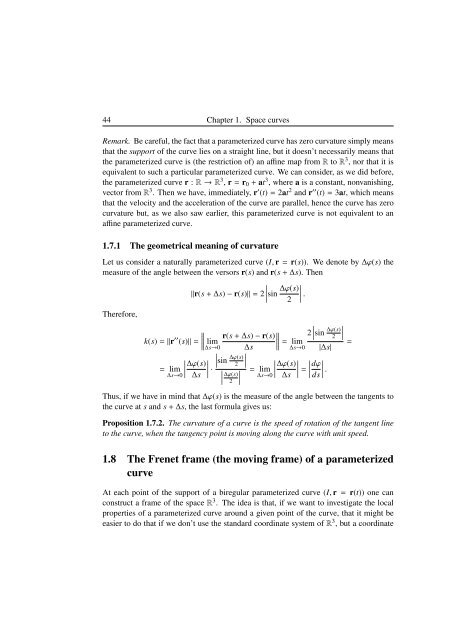Blaga P. Lectures on the differential geometry of - tiera.ru
Blaga P. Lectures on the differential geometry of - tiera.ru
Blaga P. Lectures on the differential geometry of - tiera.ru
You also want an ePaper? Increase the reach of your titles
YUMPU automatically turns print PDFs into web optimized ePapers that Google loves.
44 Chapter 1. Space curves<br />
Remark. Be careful, <strong>the</strong> fact that a parameterized curve has zero curvature simply means<br />
that <strong>the</strong> support <strong>of</strong> <strong>the</strong> curve lies <strong>on</strong> a straight line, but it doesn’t necessarily means that<br />
<strong>the</strong> parameterized curve is (<strong>the</strong> restricti<strong>on</strong> <strong>of</strong>) an affine map from R to R 3 , nor that it is<br />
equivalent to such a particular parameterized curve. We can c<strong>on</strong>sider, as we did before,<br />
<strong>the</strong> parameterized curve r : R → R 3 , r = r0 + at 3 , where a is a c<strong>on</strong>stant, n<strong>on</strong>vanishing,<br />
vector from R 3 . Then we have, immediately, r ′ (t) = 2at 2 and r ′′ (t) = 3at, which means<br />
that <strong>the</strong> velocity and <strong>the</strong> accelerati<strong>on</strong> <strong>of</strong> <strong>the</strong> curve are parallel, hence <strong>the</strong> curve has zero<br />
curvature but, as we also saw earlier, this parameterized curve is not equivalent to an<br />
affine parameterized curve.<br />
1.7.1 The geometrical meaning <strong>of</strong> curvature<br />
Let us c<strong>on</strong>sider a naturally parameterized curve (I, r = r(s)). We denote by ∆ϕ(s) <strong>the</strong><br />
measure <strong>of</strong> <strong>the</strong> angle between <strong>the</strong> versors r(s) and r(s + ∆s). Then<br />
�<br />
�<br />
�<br />
�r(s + ∆s) − r(s)� = 2<br />
� ∆ϕ(s) �<br />
�<br />
�sin �<br />
�<br />
2 � .<br />
Therefore,<br />
k(s) = �r ′′ �<br />
�<br />
(s)� =<br />
�<br />
�<br />
� lim<br />
�<br />
�<br />
�<br />
r(s + ∆s) − r(s) � 2 �<br />
�<br />
�<br />
∆s→0 ∆s � = lim<br />
∆s→0 |∆s|<br />
�<br />
�<br />
�<br />
= lim<br />
�∆ϕ(s)<br />
�<br />
�<br />
�<br />
∆s→0 �<br />
�<br />
∆s � ·<br />
�<br />
�<br />
�<br />
�sin ∆ϕ(s)<br />
�<br />
�<br />
�<br />
2 �<br />
�<br />
�<br />
�<br />
�<br />
�<br />
�<br />
�<br />
� = lim<br />
�∆ϕ(s)<br />
�<br />
�<br />
�<br />
� ∆s→0 �<br />
�<br />
�<br />
∆s � =<br />
�<br />
�<br />
�<br />
�dϕ<br />
�<br />
�<br />
�<br />
�<br />
�<br />
ds � .<br />
� ∆ϕ(s)<br />
2<br />
�sin ∆ϕ(s)<br />
2<br />
Thus, if we have in mind that ∆ϕ(s) is <strong>the</strong> measure <strong>of</strong> <strong>the</strong> angle between <strong>the</strong> tangents to<br />
<strong>the</strong> curve at s and s + ∆s, <strong>the</strong> last formula gives us:<br />
Propositi<strong>on</strong> 1.7.2. The curvature <strong>of</strong> a curve is <strong>the</strong> speed <strong>of</strong> rotati<strong>on</strong> <strong>of</strong> <strong>the</strong> tangent line<br />
to <strong>the</strong> curve, when <strong>the</strong> tangency point is moving al<strong>on</strong>g <strong>the</strong> curve with unit speed.<br />
1.8 The Frenet frame (<strong>the</strong> moving frame) <strong>of</strong> a parameterized<br />
curve<br />
At each point <strong>of</strong> <strong>the</strong> support <strong>of</strong> a biregular parameterized curve (I, r = r(t)) <strong>on</strong>e can<br />
c<strong>on</strong>st<strong>ru</strong>ct a frame <strong>of</strong> <strong>the</strong> space R 3 . The idea is that, if we want to investigate <strong>the</strong> local<br />
properties <strong>of</strong> a parameterized curve around a given point <strong>of</strong> <strong>the</strong> curve, that it might be<br />
easier to do that if we d<strong>on</strong>’t use <strong>the</strong> standard coordinate system <strong>of</strong> R 3 , but a coordinate<br />
�<br />
�<br />
�<br />
�<br />
=












